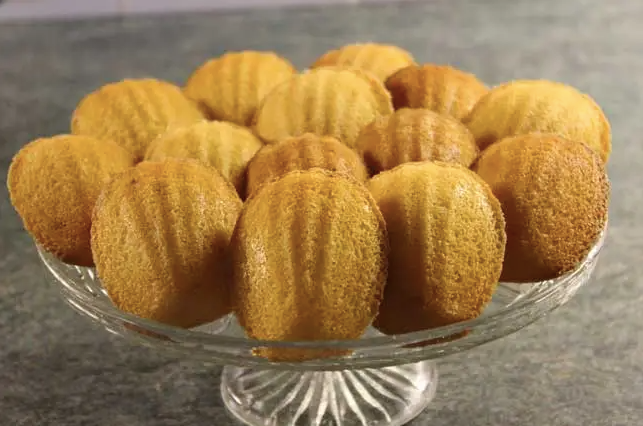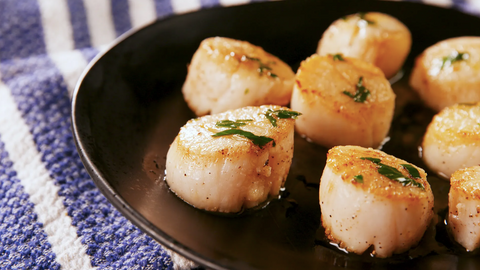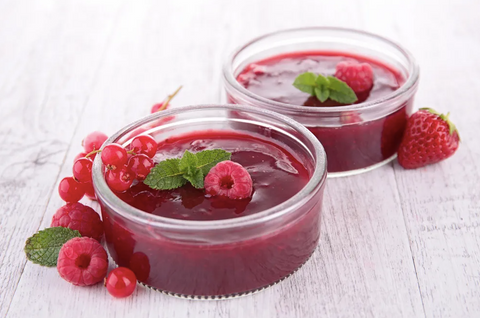Madeleines are a classic French tea cake that has recently gained popularity in the UK. These small, pillow-shaped cakes have been a favorite of foodies and dessert connoisseurs for hundreds of years, and they're not too difficult to make at home. You can also buy them in many grocery stores, bakeries, and online. Madeleines come in a wide variety of flavors, but the most popular is vanilla.
How would you describe Madeleine?
You can't get enough of the Madeleine dish. They are delicious, soft, and fluffy, just like a pound cake. The Madeleine is made with the same ingredients as pound cakes, but they are not the same thing. Instead, the Madeleine is cooked in small molds, generally shell-shaped.
- They are traditionally eaten at teatime, but you can eat them at any time of day or night. Watch out for their addictive taste!
- Madeleines are the perfect tea accompaniment, especially if you have guests over on a Sunday afternoon.
- They can be enjoyed alone or with another sweet treat like jam or chocolate spread. You can also make them more original by adding different flavors such as lemon zest or nuts to the batter.
Madeleines are so good
Because madeleines are so small, you can easily have one or two (or three) without feeling guilty. However, even though they're small, they're still packed with flavor and decadence, thanks to the rich butter and sugar used in the recipe. However, because they use flour and sugar instead of just sugar like many other desserts do, they satisfy your sweet tooth without being too overpowering or sickly sweet.
The rich buttery taste gives them a depth of flavor that you don't often get from other desserts like cookies or cakes. The texture is very light and fluffy, almost like a sponge cake on the inside, with a slightly crisp.
Why Madeleines are called Madeleines?
In a French cake, madeleines are small and shell-shaped. If you've ever wondered about the name of these sweet treats, read on!
The story of how madeleines got their name is a little complicated. It seems to have been first published in French in 1755 by historian J.-B. In his book "Histoire de l'Academie Royale des Sciences et Belles-Lettres," Gessner claims that they were invented and named by pastry chef Madeleine Paulmier (which would make her a celebrity chef at the time, if true). He also states that the Madeleine is a specialty of Lorraine, which is, of course, famous for its Quiche Lorraine. However, French encyclopedist Diderot contradicted this account in 1762 as he stated that pastry chef Madeleine was actually from Commercy, close to Nancy (in what is today called Lorraine).
- It seems that the cake did not become widely popular until the 19th century, when it was exported to Paris. While most desserts are known for being rich and decadent, madeleines are quite light and airy with a lemon flavor thanks to their delicate crumb structure, which makes them.
- It seems strange to ask how the French eat madeleines, just as it would seem odd to ask how UK people eat chocolate chip cookies. But there are differences in the way French people use these cookies.
Madeleines aren't just for tea time anymore.
The most traditional time for eating a madeleine is as an afternoon snack served with a small cup of tea or coffee. A madeleine is often the only thing eaten at that time of day. It's meant to be leisurely and relaxing, not a full meal or even a light snack.
- The sole purpose of having a madeleine with your coffee is to enjoy that moment and relax for a few minutes before going back to work or other responsibilities.
- But people also eat them with breakfast, especially children, who don't like heavy morning meals. I even had one at lunch once!
What does a madeleine taste like?
The Madeleine is a teacake from Commercy and Liverdun in the Lorraine region in northeastern France. The name also refers to a similar cake in Spanish cuisine.
Madeleines are very small sponge cakes with a distinctive shell-like shape acquired from being baked in pans with shell-shaped depressions. Aside from the traditional molded pan, commonly found in stores specializing in kitchen equipment and even hardware stores, no special tools are needed to make them.
Why do Madeleines taste so good?
You can't even talk about madeleines without referring to Proust and the memories they conjure up. The story goes that Marcel Proust, a French novelist, and critic, dipped his Madeleine in tea and instantly connected the taste with his childhood.
Madeleines are not only delicious, but they also have an incredible history dating back to 1755, when they were first created in Commercy during the reign of King Louis XV. These little cakes are native to France, where they are still enjoyed today.
- Madeleines are made from a simple batter that is baked in shell-shaped pans. The result is a very light cake that is moist inside with a subtle crunchy outside.
- They're enjoyed plain or sprinkled with powdered sugar for breakfast or as an afternoon treat. They're also used as a base for many French desserts like trifles and savory dishes like seafood salad and cheese souffles.

Madeleines are easy to make
The great thing about madeleines is that they're not difficult to make, yet they're impressive and delicious. The texture is like a cross between a cookie and a cake, but the flavor is superior to either. We love the simple flavors of vanilla and lemon, but you can easily add other flavors, such as chocolate or almond extract.
The batter comes together in under 10 minutes with just a bowl and a whisk. Just be sure to chill it overnight, so you get those lovely curves when they bake.
Madeleine is shaped like a Shell
The shell shape of the Madeleine has been linked with a legend of a monk who lived in a monastery near Commercy, France. The code says that the Duke of Lorraine was passing through Commercy on his way to fight in the Crusades. He stopped at the monastery and was served madeleines by the monk. The duke was so fond of the sweet cakes that he asked for their recipe to take it with him to war.
The monk replied that if he liked them so much, he would send it to him by mail written on a shell (the conch), where Madeleine's shape comes from.
What did Proust say about madeleines? As Proust tells it, he was dunking a thin madeleine cake into a cup of linden tea when the memories came flooding back. The taste of madeleines and linden tea reminded him of his childhood and his Aunt Leonie, who would serve the confections with lemony tea.
"No sooner had the warm liquid mixed with the crumbs touched my palate than a shudder ran through me, and I stopped, intent upon the extraordinary thing that was happening to me," he wrote in "Swann's Way." "An exquisite pleasure had invaded my senses, something isolated, detached, with no suggestion of its origin. And at once, the vicissitudes of life had become indifferent to me, its disasters innocuous, its brevity illusory — this new sensation having had on me the effect which loves has of filling me with a precious essence; or rather this essence was not in me it was me."
Madeleines are served with;
Madeleines are small shell-shaped sponge cakes traditionally served with coffee, tea, or hot chocolate. They can also be served topped with fruit or with a dollop of whipped cream. The origin of madeleines is not entirely certain, but it is believed that they were first created in the town of Commercy in the Lorraine region of France.
How do you make a madeleine hump? The key to a perfect madeleine is that classic hump, or as the French say, la bosse. It's the hallmark of the traditional cake. The good news is it's not hard to get a nice hump on your madeleines. Just follow these five steps:
- Chill your batter in the fridge overnight or for at least two hours.
- Use a nonstick madeleine pan, if possible. Even with buttering and flouring (or using baking spray), you will still have some sticking issues if you use a regular pan.
- Bake the cakes at high heat — 350 degrees F — until they're golden brown on top (but don't over bake them, or they'll be dry).
- Let them rest in the pan for 10 minutes before removing them from the pan so they won't break apart while you're trying to get them out of the pan.
- Serve them warm from the oven when they're still slightly puffed!
Difference between Cake and Madeleine
There are many differences between the two cookies, but below are some of the most pronounced:
Texture: Madeleines have a slightly dense, spongy texture. They're soft but not crumbly like a cake. On the other hand, Macarons are crunchy, with an airy mixture sandwiched between their two shells.
Taste: Madeleines have a vanilla-sweet flavor that tastes much more like cakes than cookies. This is because they do not have any filling and instead get their flavor from sugar and eggs. On the other hand, Macarons taste primary like whatever they're filled with - chocolate ganache is one of the most popular flavors.
Shapes: Perhaps one of the easiest ways to distinguish between madeleines and macarons is to look at their shapes. Madeleines come in small shell shapes, while macarons are always round and sandwiched together with a filling in between.
Avoid Madeleines from sticking
To prevent your madeleines from sticking to the pan, use a nonstick silicone madeleine pan or butter and flour a metal pan. If you use a nonstick metal pan, there is no need to butter and flour it. Be sure to place the prepared pans in the refrigerator for at least 15 minutes before baking.
Make sure the batter is not over mixed for baked goods such as madeleines or muffins. Over mixing can lead to tough baked goods. In addition, over mixing incorporates too much air into the batter, which means that your baked goods will rise quickly and deflate when cooling.
Difference between Madeleine and a Financier
A financier is a cake made of groundnuts and egg whites with a texture similar to a dense pound cake. It can be made round or rectangular and often has a dark brown crust on the outside and a moist and dense yellow interior. It is usually eaten as an afternoon snack with tea, coffee, or milk.
A madeleine is a shell-shaped sponge cake with lemon, orange, or vanilla flavors. They are baked in special molds to get the shell shape. Madeleines are often eaten for breakfast or dessert.
How to serve Madeleines
They are served traditionally with afternoon tea or plain as part of a dessert or dessert buffet. They may also be dipped into wine, like ladyfingers, eaten with fruit, spread with jam or chocolate, or sprinkled with sugar. A variation of the French madeleine recipe is the "petite madeleine," which is injected with orange blossom syrup after being baked.
Serve Madeleine warm with a cup of coffee or tea. Because madeleines are such a simple dessert, serve them plain or with a little bit of melted chocolate on top.
- If you want to serve your Madeleine warm, the best way to do that is to put them in a basket or a plate with a napkin covering it. Then, if you want, you can heat them in the oven for about 10 minutes.
- If you are not going to eat them immediately, you must wrap them in plastic wrap or store them in an airtight container. You should keep them at room temperature, but they will last longer if you keep them in the refrigerator.
- They are traditionally eaten as they are, without adding any sugar or butter on top.
In the end we can say that you must have to taste these fluffy Madeleines.
References
https://sallysbakingaddiction.com/madeleines/
https://sugarspunrun.com/madeleines/
https://bakerbynature.com/classic-french-madeleines/




